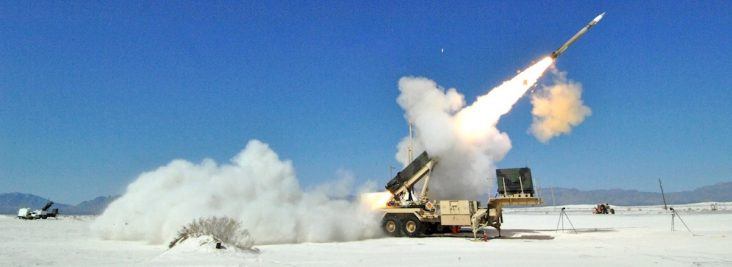Lockheed Martin emerges from Farnborough Airshow with big deals in the pipeline, could help Arkansas operations
by July 18, 2016 1:00 pm 278 views

The nation’s largest defense contractor emerged from Farnborough International Airshow in the United Kingdom last week with a long list of new contracts and big deals in the pipeline that may extend or provide new opportunities for the company’s military-industrial site in south Arkansas.
While Gov. Asa Hutchinson and his economic development staff were busy meeting with more than 20 companies during the administration’s fourth international trade mission last week, including a two-day stint at the Farnborough trade show, Lockheed Martin left the weeklong aerospace and defense industry meeting in London with headlines of big business deals across Europe, Asia and the U.S.
On the first day of the Farnborough event, which is billed as the largest global international airshow for the aviation, aerospace and defense industries, Lockheed Martin officials and Gov. Rick Scott announced plans for the nation’s largest defense contractor to expand capabilities at its Astrotech Space Operations site in Titusville, Fla., creating up to 300 jobs.
“Florida is home to one of the largest aerospace and aviation industries in the nation and we continue to grow,” Gov. Scott said. “It’s exciting that Lockheed Martin continues to expand in Florida, adding hundreds of jobs for our families. We will do all we can to make it easier for businesses like Lockheed Martin to succeed in Florida.”
Lockheed Martin officials said they considered a number of locations across the country that could handle additional work and selected Brevard County in Florida because of the area’s talented aerospace workforce and additional business opportunity for the new project.
Florida economic development officials said the Astrotech Space Operations offers payload processing services – like encapsulating and fueling a satellite for launch – for a range of customers. Under the planned expansion, the scope of work could potentially include production of aerospace components and subsystems.
But the Astrotech deal with Florida economic officials was just appetizer for an even bigger Lockheed Martin announcement at the London airshow. On Wednesday (July 13), Lockheed Martin announced the much-awaited unveiling of its a European-built, armed Sikorsky Black Hawk helicopter, showcasing a range of advance military weaponry that can be integrated onto the multirole gunship. The Bethesda, Md.-based defense giant, which acquired Black Hawk maker Sikorsky for $9 billion only a year ago, also said it had received a new order for 24 advanced helicopters from an unnamed buyer. Twenty-six militaries across the globe now operate the combat chopper.
But the U.S.-defense giant was not through making news in London and across the globe. On the last day of the trade show (Friday, July 15), Lockheed Martin at the company’s headquarters outside Washington, D.C., announced plans to invest more than $3 billion to pursue the U.S. Army’s request for proposals for a new advanced radar network to replace the current and aging Patriot radar system.
“With this request for information, the Army recognizes that a new radar is required to meet the current and emerging air and missile defense threats. This is an important milestone, another clear indication that the Army recognizes the aging Patriot weapon system is insufficient to meet modern air and missile defense operational requirements,” said Tim Cahill, vice president of Lockheed’s Air and Missile Defense. “We welcome the opportunity to provide state-of-the-art radar technology that will address the operational and logistic deficiencies of the Patriot.”
That announcement may be good news for Lockheed’s operations in Camden, which are part of the company’s military-focused Air and Missile Defense division. Just before the Farnborough airshow began, the Pentagon announced July 8 it had agreed to equip South Korea with the company’s Terminal High Altitude Area Defense (THAAD) missile-defense system, which Is partly produced by Lockheed Martin workers at the company’s rocket and missile-building industrial site in the East Camden.
In February, Lockheed Martin’s Missile and Fire Control (MFC) division based in Grand Prairie, Texas, received a $200 billion extension to a previously awarded fixed-price contract for production of 20 additional Lot 8 Interceptors and associated production support efforts for the Pentagon’s THAAD project office in Huntsville, Ala.
With those adjustments, the total cumulative face value of the contract was revised upward by 29% to $882 million from the previous $683.3 million, DOD officials said. The work on the THAAD system will be performed at Lockheed Martin’s MFC manufacturing locations in East Camden; Grand Prairie, Texas; and Huntsville, Anniston and Troy, Ala.
According to Lockheed Martin officials, THAAD is capable of defining countries and entire regions against short and medium range ballistic missiles by basically knocking them out of the sky and rendering them useless. THAAD interceptors employ Lockheed Martin’s proven “hit-to-kill” technology to destroy missile threats inside and outside the atmosphere, the company said.
In announcing its agreement with South Korea, Pentagon officials said the decision to deploy the THAAD system on the Korean Peninsula is “to ensure the security of the (South Korea) and its people, and to protect alliance military forces from North Korea’s weapons of mass destruction and ballistic missile threats.”
